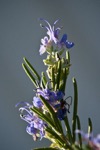| Scientific: | Rosmarinus officinalis |
|---|---|
| Other: | Rosemary |
| Family: | Lamiaceae |
Rosemary is a culinary herb belonging to the mint family that shares similar phytochemicals and associated medical actions to herbs like peppermint, sage and lemon balm.
- The German Commission E approved the internal use of rosemary leaf for dyspeptic complaints and external use as supportive therapy for rheumatic diseases and circulatory problems. The presence of essential oils makes rosemary a useful carminative herb for bloating and gas.
Over a thousand research studies are published on rosemary and its related phytochemicals. In addition to the presence of essential oils, rosemary leaf is rich in various phenolic compounds, diterpenoids and triterpenoids that show benefit on the cardiovascular and central nervous system. In vivo and in vitro studies demonstrate lipid-lowering and anti-inflammatory effects of the whole herb extract of reosemary. Also, it improves endothelial function and microcirculation. However, studies on the prevention or treatment of cardiovascular diseases with rosemary are scarce. Anecdotally rosemary may be associated with longevity. In Acciaroli, Italy where the population consumes rosemary daily, the population is known to have some of the highest percentages of centenarians in the world. Scientists suspect that in addition to lifestyle and other dietary factors, their high consumption of rosemary may contribute to their health.
Several studies demonstrate that rosemary improves cerebrovascular circulation and helps with memory making it potentially useful in young students but also elderly suffering from dementia and Alzheimers. Also compounds in rosemary interact with receptors in the GABA system and monoaminergic system to reduce anxiety and depression, and improve sleep quality.
Topically the essential oils can be used for several conditions. Rosemary essential oil is a popular ingredient in shampoo because of its pleasant scent and one study showed it aided hair growth in patients suffering from androgenetic alopecia. The antiseptic effects of the essential oil and also impart it with antiviral, antifungal and antibacterial properties.
Gastrointestinal
• digestive complaints with bloating and gas causng cramps:
• flatulence
• colic
• irritable bowel syndrome (IBS)
CNS
• mild depression (traditional use)
• poor cerebral circulation
• poor cognition & memory
• sleep
• Alzheimer's disease
Infection (topical application)
• cold sores
• herpes simplex (HSV)
Dermatologic
• cold sores
• alopecia (hair rinse)
Muscolskeletal
• osteoarthritis (OA)
• rheumatoid arthritis (RA)
Cancer
• colorectal cancer
• breast cancer
• liver cancer
• stomach cancer
• melanoma
• leukemia
• Circulatory stimulant
• Antidepressant
• Antiinflammatory
• Nootropic
• Carminative
• Antiseptic
• Antimicrobial
• Antiviral
• Emmenagogue
• Anticancer
• Hepatoprotective
• Antioxidant
• Cholagogue
• Rubefacient
• Hypolipidemic
• Volatile Oil
• Phenolic Acids (Rosmarinic Acid)
• Diterpenes (Carnosol, Rosmanol)
• Triterpenes (Ursolic Acid )
• Tincture (1:5 in 40% EtOH): 1-2 ml tid
• Liquid extract (1:1 in 45% EtOH): 2-4 ml tid
• Infusion (dried herb): 1-2 g tid
Generally considered safe when used as indicated.
Caution: Pregnancy; mild emmenagogue activity.
Barnes J, Anderson LA, Phillipson JD. Herbal Medicines, 3rd ed. London: Pharmaceutical Press, 2007.
Bone K. Principles and Practice of Phytotherapy. Edinburgh: Churchill Livingstone, 2000.
Bone K. A Clinical Guide to Blending Liquid Herbs: Herbal Formulations for the Individual Patient. St Louis, MO: Churchill Livingstone, 2003.
Brinker F. The Toxicology of Botanical Medicines, 3rd ed. Sandy, Oregon: Eclectic Medical Publications, 2000.
Felter HW, Lloyd JU. King's American Dispensatory. 1898. http://www.ibiblio.org/herbmed/eclectic/kings/main.html. Accessed: August 19, 2006.
Hoffman D. Medical Herbalism. Rochester, Vermont: Healing Arts Press, 2003.
Weiss RF. Herbal Medicine. Beaconsfield, England: Beaconsfield Publishers Ltd, 1988.
Williamson EM, ed. Major Herbs of Ayurveda. Edinburgh: Churchill Livingstone, 2002
Disclaimer: This content is subject to change. The information is intended to inform and educate; it does not replace the medical evaluation, advice, diagnosis or treatment by a healthcare professional. www.nhpassist.com © 2014 NDAssist Inc. and/or its affiliates. All rights reserved.

|
Rosemary
SummaryRosemary is a culinary herb belonging to the mint family that shares similar phytochemicals and associated medical actions to herbs like peppermint, sage and lemon balm. IndicationsSign in requiredActionsSign in requiredConstituentsSign in requiredPosologySign in requiredSafetySign in requiredReferencesSign in required |
|---|